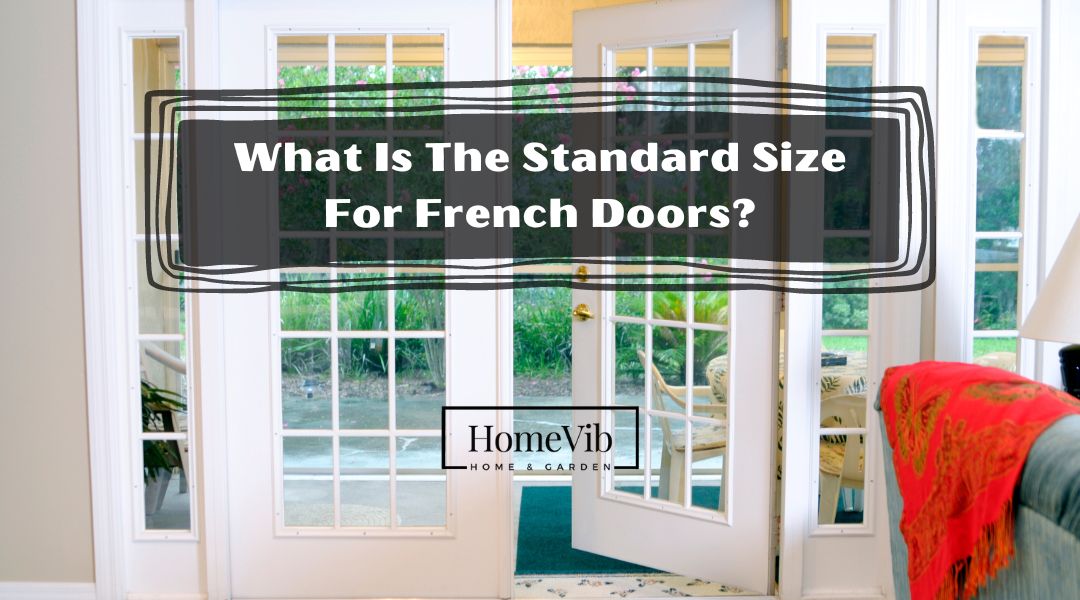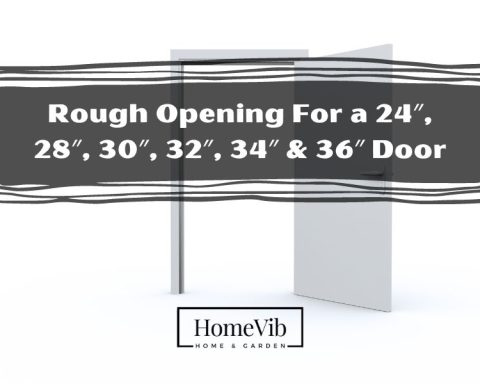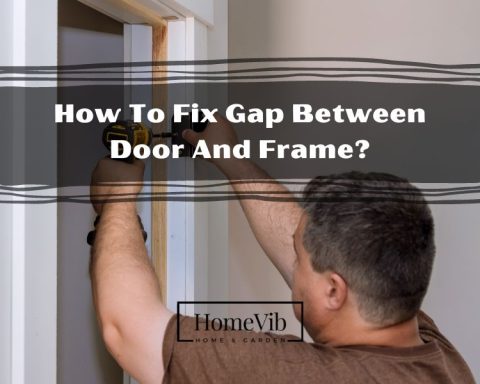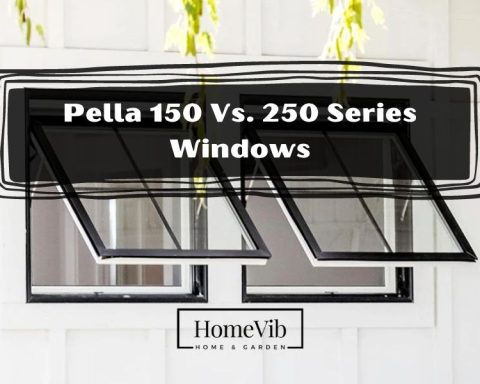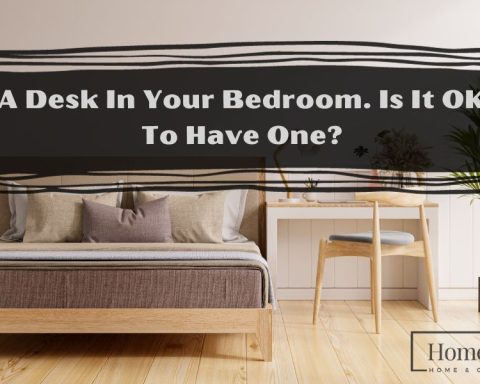If you’re purchasing a new home, one of the essential parts to consider is what type of doors you’ll use. The doors themselves can be especially tricky. Many people need to decide which ones to pick. This is because many different types of doors may work for your situation.
If you’re asking yourself what type and size of French doors to buy, keep reading. This post should clear up some confusion. Below is a range of standard sizes you can use to find your French door.
The standard size dimensions for a set of French doors are 80 inches long and 72 inches wide. French doors often come in widths ranging from 5 to 8 feet. This means that they can serve as passageways to spaces of varying dimensions.
What Are the Typical French Door Sizes?
The typical dimensions for a French door are 80 inches long and 72 inches wide. French doors also come in widths of 5 and 8 feet.
Some of the most popular forms of façade are French doors, known as double doors or double windows. So, precise measurements are necessary for a successful installation at home.
French doors installed on the exterior of a building come in a range of sizes. Standard exterior French doors range in height from 6.7 feet to 8 feet.
Larger French doors with wide openings are an alternative for rooms with plenty of space. Depending on the manufacturer, you can find French doors up to 10 feet wide.
You can also find these French door sizes:
- 32-inches width and 80-inches height
- 28-inches width and 80-inches height
- 36-inches width and 80-inches height
- 30-inches width and 80-inches height
- 60-inches width and 80-inches height
- 48-inches width and 80-inches height
What Are the Usual Parts of a French Door?
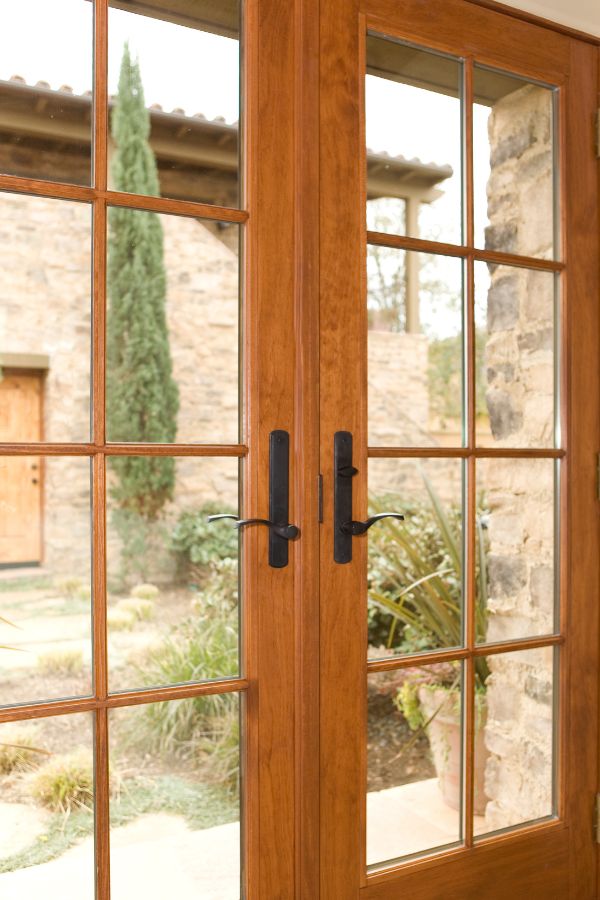
French doors consist of two standard doors placed side by side in a door jamb. The doors are a one-of-a-kind design feature due to the many divided lights that make up the glass.
Standard French door components include:
Sill and Bottom Sweep
The door’s sill and bottom sweep provide extra layers of protection from the elements.
Corner Seal Pads
You can install corner seal pads to keep wind-driven moisture out of the door and your home. This is to block the bottom corner of the door.
Hinges
Hinges serve to hold the door against the weatherstripping. It also prevents water from leaking in via the hinges.
Weatherstripping
Weatherstripping is a key component in a door’s ability to conserve energy.
Multi-point Locking System
This helps maintain the weatherstripping’s effectiveness even at high wind speeds.
Lip-Lite Case
It strengthens the glass’s surrounding frame and acts as a sealant to keep it in place.
Variations To Standard French Doors
Traditional French doors feature two panels that swing either inward or outward. Because of their transparency, owners place them in the backyards of residential buildings.
There is a wide variety of French doors available to architects and homeowners. You may classify them as internal or exterior.
Interior French doors
The primary functions of interior French doors are the transmission of light. It also serves to create an illusion of space between rooms. They may be transparent or opaque, glazed or draped. These doors bridge the gap between two spaces between typical doors.
Interior French doors are 36 inches wide. With this dimension, the clear opening for the door will be 72 inches. One-third of an inch is the industry standard for door thickness.
Exterior French doors
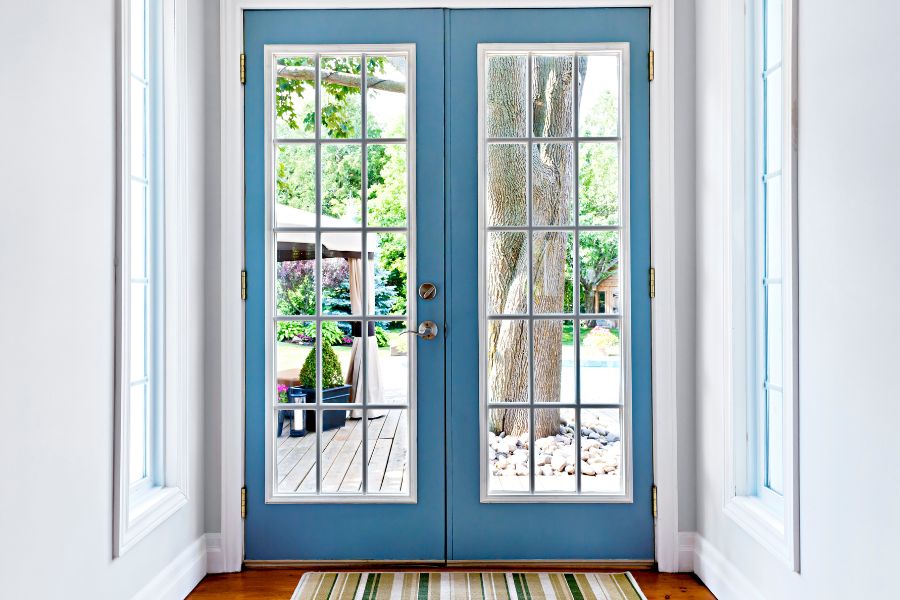
French doors for the exterior are the safest option and save energy costs. Although a bright and airy interior is enticing, a homeowner should feel secure. This is knowing that their exterior doors will keep unwanted guests away.
A customary external French door’s width can range from 24 to 42 inches. Their height can be any value between 6.7 and 8 feet. Standard sizes for outside French doors range from 5 to 8 feet in width.
How Do You Measure For French Doors?
For French doors, it’s best to measure from the inside of the door frame.
Then, round up the results of three separate measurements. When taking measures, keep in mind the following:
Step 1: The first step in taking accurate measurements is to remove the internal trim from the door frame. You can only get an accurate rough opening measurement by removing the molding.
Step 2: Determine the height and width of the opening. A correct height measurement begins at the threshold and ends at the foot of the header.
Step 3: Measure from one side of the opening to the other to get the exact width.
Step 4: To complete the look, you should also measure the depth of the jamb.
Step 5: You must determine if your French door swings outward or inward. You need to check if the door swings to the right or left by standing outside.
Should French Doors Open In Or Out?
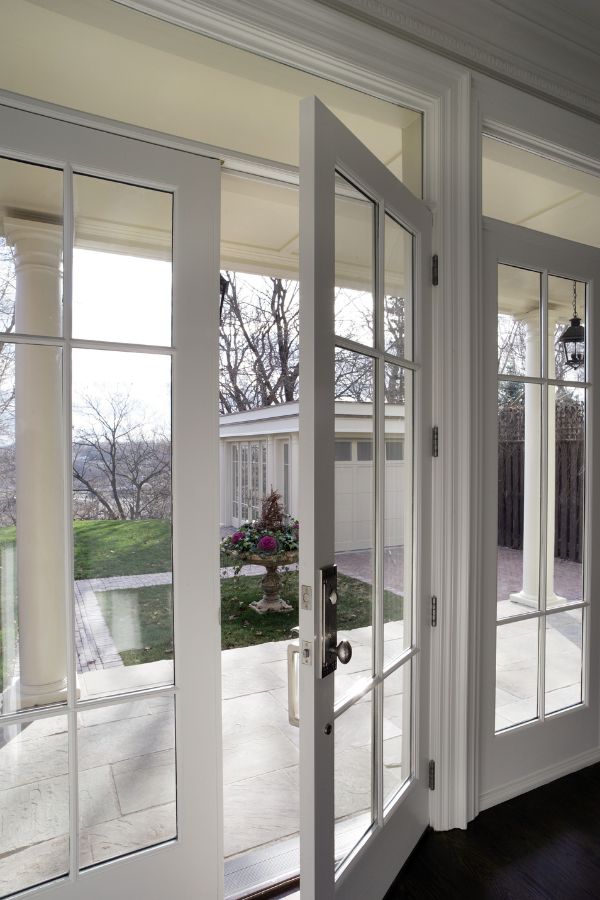
In most cases, French doors should have an inward-opening configuration. You can use it as a barrier between indoor space and the outside.
Weather protection is easier to provide for doors that swing inward. It’s easier to open a door that swings out than one that swings in.
Still, there are times when outward-swinging doors are necessary or wanted. You will have to pay more for these doors because the door slabs will have to be weatherproof on the edges.
The hinges will have to be security hinges both inside and out. In contrast, the door jamb will have to be weather-stripped in a very different way.
Keep in mind
Doors that open outwards fit into a recess all around, giving the door strength all the way around. Doors that open inwards are only as safe as their bolts and locks, which are far less sturdy and secure.
Are French Doors Always Double?
No, not all French doors are double doors.
Even though French doors usually come in pairs, you can buy them alone. French doors come in a large variety of selections. These include single doors, bifold doors, and sliding doors.
The atrium door and French door both come in single and double versions. The traditional look of a French door is mullions and muntins holding panes of glass in place.
But, it is often imitated by using a single pane of glass. These are like an atrium door and a snap-in component that mimics the muntins.
Atrium doors and French doors are typical of the mid-century modern style. They serve to let in more light and create an outdoor atmosphere indoors.
French doors are alternative to patio doors because of their large glazed panels.
Meanwhile, you can find double doors in both commercial and residential buildings. The larger versions of these doors feature either a smaller glass pane or none.
For double doors, there is a universal standard for height is 80 inches. In most cases, two doors will be:
- 60″ (2 x 30″) (2 x 30″)
- 64″ (2 x 32″) (2 x 32″)
- 72″ (2 x 36″) (2 x 36″)
The optional sidelight panel is not factored into these dimensions.
What Is The Best Material For French Doors?
The best materials for French doors are UPVC, composite, aluminum, and timber.
UPVC
The most cost-effective choice is a set of uPVC French doors. Although uPVC is less expensive than other insulation materials, it performs aesthetically. It does not need maintenance.
Despite its high-quality characteristics, it is rarely favored for its aesthetics. Yet uPVC is widely utilized for window frames. French doors should look good if they complement the windows in the rest of your house.
Timber
Because of its attractive appearance, timber is the most sought-after material. Choose softwood if you’re installing it inside, but go with hardwood if you want it to last a long time outside. They are paintable, so you may customize their look to match your interior.
Composite
Composite is durable and will aid in enhancing the safety of your property. It consists of uPVC edges, timber cores, and glass-reinforced polymers.
Aluminum
Installing French doors is a big deal, so you want to ensure they’ll last for years. Due to its high strength and durability, it is resistant to corrosion. Additionally, it provides good insulation.
When to Use French Doors?
French doors are a great choice if you want to add a touch of class to your home. You don’t even without sacrificing any practicality.
French doors have increased in popularity among homeowners. It’s a lovely addition to any house to enhance its aesthetic value.
Their features include a wooden frame and separated glass panes that take up most of the door. Because of the design of a French door, you can use the entire opening.
The best way to use French doors is to install them indoors or outdoors. It can serve as a divider between the living room and dining room without making either room feel too small. The glass in the doors makes the spaces feel integrated rather than isolated. They serve the practical purpose of dividing one room from another.
French doors are a popular choice for both patio and interior applications too.
Patio: Patio French doors lead out onto the deck or patio in the backyard.
Interior: Another common location is between the kitchen, dining area, and living room.
Though they are attractive, these entrances are only appropriate for some homes. This is because of their unique design. So before investing in a French door, ensure it will be an asset rather than a detriment to your property.
Keep in mind
If the French door doesn’t match the style of the rest of the house, it can be very distracting.
Advantages of French Doors
Here are some of the advantages of French doors:
Security
French doors offer a degree of adaptability. It can also incorporate built-in locks with relative ease. They are durable with adjustable hinges and high-security espagnolette locks for maximum safety.
Light
French doors let in as much natural light as windows, if not more. French doors are a great alternative to windows for more natural light. They also create a new feel in any room of the house.
Access
French doors are incredibly useful. When you have more than one entrance to your home, you have options for bringing bigger items inside. These could be like hosting parties and gatherings. As well as that, you could enjoy the convenience of having more than one entrance.
Equity
Putting up French doors is a surefire way to boost your home’s resale price. As a beautiful and desirable feature, French doors can help sell a home.
Reduce Electricity
French doors can cut your heating and cooling bills in half every month. Unlike sliding doors, which take time to open and close. You can open and close French doors in a matter of seconds, cutting down on air loss.
Disadvantages of French Doors
Below are a few drawbacks of French doors:
Space
The doors open outward in this structure, so you’ll need some extra space to open them. French doors may not work well on balconies or patios with limited space. This is especially true if there is outside furniture to use.
Confidentiality issues
French doors let in a lot of natural light and consist of almost glass. As a result, there may be better choices for homes where privacy is a priority. For example, you can add privacy by hanging curtains or blinds. But unlike sliding patio doors, you can’t push the door open a little to get in.
Energy Usage
French doors have trouble maintaining warmth in the winter because of their glass. You can avoid this by installing double-pane glass, but the price will rise if you glaze large doors.
Costs
Even though they improve the look of a space, they also increase the associated costs. The price of a French door is more than that of a regular solid door. It’s still worth considering if you’re in the middle of other renovations.
Installation
A door of this design requires professional installation. While this is possible, you may want to see a professional installation. Fortunately, most stores that make them also perform the necessary installations.
How Much Do French Doors Cost?
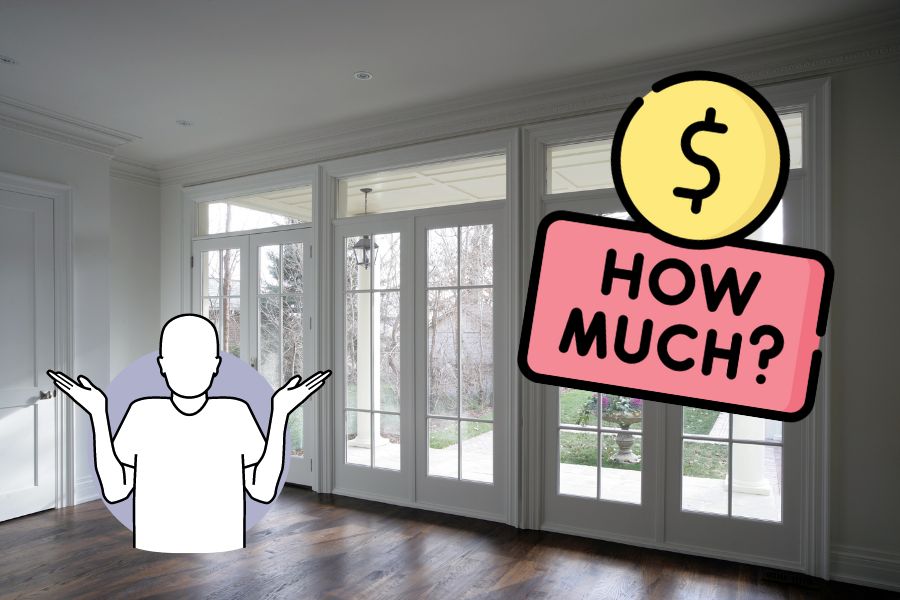
French doors typically cost between $2,000 and $5,000, with an average price tag of $3,500.
Outdoor or indoor French doors can completely change the feel of your home. But their price can range from a few hundred to tens of thousands of dollars. It will depend on the size, material, and placement.
French patio doors are the safest to install if you need a door with many customization options:
Cost: French patio doors are 10-20% more expensive than sliding doors.
Style: French patio doors come in a variety of stylish configurations.
Repair & Maintenance: French patio doors put a lot of pressure on hinges and may need adjusting.
Space: French patio doors interfere with wall and floor space.
Interior French Doors Cost
Solid French Double Doors 56 x 80 inches
Prices for interior French doors range from $500 to $800. Unfortunately, you cannot use the interior of a building due to its lack of durability. The most commonly used softwoods for interior French doors are pine, alder, and fir.
Exterior French Doors Cost
A new outside door will typically cost between $1,500 and $4,000. In addition, exterior French doors are often heavier than interior doors.
How Much Does It Cost To Install French Doors?
An expert installation of French doors can run you an average of $200 to $800. Installing French doors can take anywhere from two to five hours. Hiring a professional will cost you between $70 and $120 an hour.
Materials
The ultimate price can vary widely depending on the door style you pick. Depending on the quality, a mass-produced door could cost $400–$2000. But a custom customized door could cost $8000 or more.
Roof Overhangs
A roof overhang extension may be necessary. You should install an awning should over the front door. One can buy a simple awning for $100–$500, while a motorized one will run you $900–$3,000.
Ramps, Landings, Platforms, and Platforms
A brick walkway measuring 25 feet in width and 4 feet in depth could cost anywhere from $800 to $1,500 to have installed. A deck can range from $15 to $35, depending on the materials used to construct it.
Molding and Embellishing
The door will need molding on the interiors and exterior trimming. Both of which add to materials and labor costs. You can buy a door trim kit for $150-$300.
How To Secure French Doors?
A Kibblock is the most secure method of locking French doors that lead to the outdoors.
Kibblock
It uses a unique interlocking system that makes breaking harder than a standard lock. So when you don’t need access from the outside, a Patlock across the interior handles is your best bet.
Glazing
The fragility of glass makes it simple to break, even tempered glass. If someone were to smash a neighboring window, they could reach in and grab the extra key.
If the door had a thumb turn, turn it to unlock it, rendering the lock useless. Therefore, it is essential to get impact-resistant glass instead of strengthened glass.
Sash Lock
You can use a sash lock to disguise a lock mechanism rather than being surface-mounted. For example, you can secure your door by installing bolts at the top and bottom. You can achieve this with the former connecting to the door frame and the latter to the floor.
Three Point Lock
One option is to install a noisy and difficult-to-dismantle three-point lock. Then, unless they have a good cause, robbers won’t try to enter your home from the roof.
Where Did French Doors Originate?
We can trace back the invention of French Doors back to Renaissance-era France. It is when residents there desired more glass in their buildings.
16th Century
In the late 16th Century, France triumphed over Italy in battle. They brought home not only bragging rights but also a variety of Italian artworks. It is an understanding of the architectural influences of the time.
They crafted the first from wood and had Renaissance hallmarks like symmetry. But, as well as that, it comes with proportion, regularity, and a bit of glass illumination.
17th Century
Shortly, the style arrived in the 17th Century 100 years later. Then, French doors made their way to England, and while it took us a little longer to “cotton on,” it was well worth the wait.
Architecture reached a high level of development under the influence of new ideas. For example, French doors are a stylish way to let in lots of light and draw attention. The doors resemble windows and appear to be sitting on floor-to-ceiling balconies.
They use French doors as balcony access points. It gained popularity as a structural element across Europe due to the natural light it lets in.
Currently, French doors are popular globally. They are an eco-friendly option because they keep your houses warm in the winter and cool in the summer. Sliding designs, and improved home security, are all under its reach of it.
Why Are French Doors Called French Doors?
The name “French door” comes from the idea that they came from France. French doors are called portes-fenetres, which means “window doors.”
At first, they were floor-to-ceiling window casements. They were also called French windows. Their primary purpose was to let natural light seep from one room to the next. That gives people more light rather than electricity. As mentioned earlier, they were first used in English and American architecture.
French doors are often used on the inside of homes today more as a design element than as a way to let light in. Yet, unlike other doors, the French door served as more than an entrance. Instead, they used it as an extension to the windows, making it popular by the name French doors.
For many years, French doors have been an alternative to glass patio doors for homeowners. French doors may seem dated until it’s time to replace them. Yet, for 2022 and beyond, these doors will continue to be quite fashionable.

